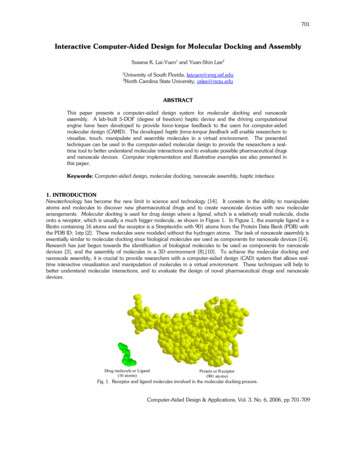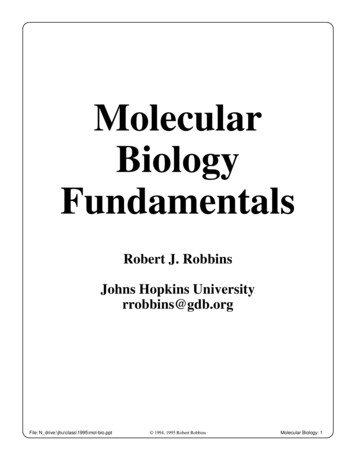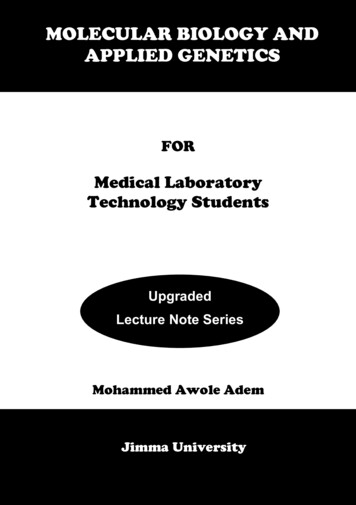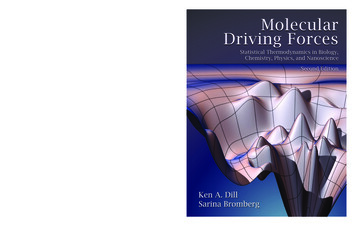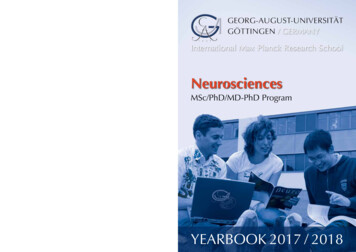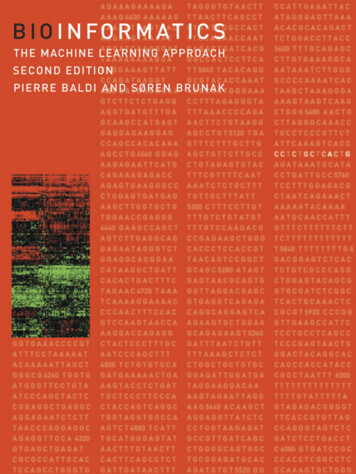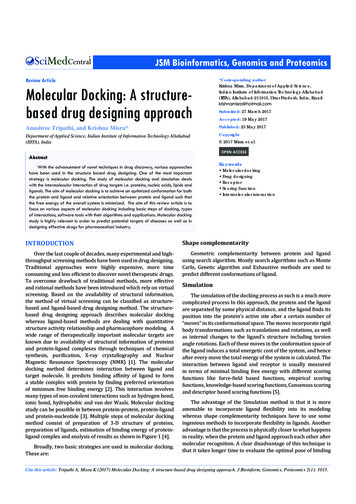
Transcription
Central Bringing Excellence in Open AccessJSM Bioinformatics, Genomics and ProteomicsReview ArticleMolecular Docking: A structurebased drug designing approach*Corresponding authorKrishna Misra, Department of Applied Science,Indian Institute of Information Technology Allahabad(IIITA), Allahabad-211015, Uttar Pradesh, India, Email:Submitted: 27 March 2017Accepted: 19 May 2017Published: 23 May 2017Anushree Tripathi, and Krishna Misra*Department of Applied Science, Indian Institute of Information Technology Allahabad(IIITA), IndiaCopyright 2017 Misra et al.OPEN ACCESSAbstractWith the advancement of novel techniques in drug discovery, various approacheshave been used in the structure based drug designing. One of the most importantstrategy is molecular docking. The study of molecular docking and simulation dealswith the intermolecular interaction of drug targets i.e. proteins, nucleic acids, lipids andligands. The aim of molecular docking is to achieve an optimized conformation for boththe protein and ligand and relative orientation between protein and ligand such thatthe free energy of the overall system is minimized. The aim of this review article is tofocus on various aspects of molecular docking including basic steps of docking, typesof interactions, software tools with their algorithms and applications. Molecular dockingstudy is highly relevant in order to predict potential targets of diseases as well as indesigning effective drugs for pharmaceutical industry.Keywords Molecular docking Drug designing Receptor Scoring function Intermolecular interactionINTRODUCTIONShape complementarityOver the last couple of decades, many experimental and highthroughput screening methods have been used in drug designing.Traditional approaches were highly expensive, more timeconsuming and less efficient to discover novel therapeutic drugs.To overcome drawback of traditional methods, more effectiveand rational methods have been introduced which rely on virtualscreening. Based on the availability of structural information,the method of virtual screening can be classified as structurebased and ligand-based drug designing method. The structurebased drug designing approach describes molecular dockingwhereas ligand-based methods are dealing with quantitativestructure activity relationship and pharmacophore modeling. Awide range of therapeutically important molecular targets areknown due to availability of structural information of proteinsand protein-ligand complexes through techniques of chemicalsynthesis, purification, X-ray crystallography and NuclearMagnetic Resonance Spectroscopy (NMR) [1]. The moleculardocking method determines interaction between ligand andtarget molecule. It predicts binding affinity of ligand to forma stable complex with protein by finding preferred orientationof minimum free binding energy [2]. This interaction involvesmany types of non-covalent interactions such as hydrogen bond,ionic bond, hydrophobic and van der Waals. Molecular dockingstudy can be possible in between protein-protein, protein-ligandand protein-nucleotide [3]. Multiple steps of molecular dockingmethod consist of preparation of 3-D structure of proteins,preparation of ligands, estimation of binding energy of proteinligand complex and analysis of results as shown in Figure 1 [4].Geometric complementarity between protein and ligandusing search algorithm. Mostly search algorithms such as MonteCarlo, Genetic algorithm and Exhaustive methods are used topredict different conformations of ligand.Broadly, two basic strategies are used in molecular docking.These are:SimulationThe simulation of the docking process as such is a much morecomplicated process In this approach, the protein and the ligandare separated by some physical distance, and the ligand finds itsposition into the protein’s active site after a certain number of“moves” in its conformational space. The moves incorporate rigidbody transformations such as translations and rotations, as wellas internal changes to the ligand’s structure including torsionangle rotations. Each of these moves in the conformation space ofthe ligand induces a total energetic cost of the system, and henceafter every move the total energy of the system is calculated. Theinteraction between ligand and receptor is usually measuredin terms of minimal binding free energy with different scoringfunctions like force-field based functions, empirical scoringfunctions, knowledge-based scoring functions, Consensus scoringand descriptor based scoring functions [5].The advantage of the Simulation method is that it is moreamenable to incorporate ligand flexibility into its modelingwhereas shape complementarity techniques have to use someingenious methods to incorporate flexibility in ligands. Anotheradvantage is that the process is physically closer to what happensin reality, when the protein and ligand approach each other aftermolecular recognition. A clear disadvantage of this technique isthat it takes longer time to evaluate the optimal pose of bindingCite this article: Tripathi A, Misra K (2017) Molecular Docking: A structure-based drug designing approach. J Bioinform, Genomics, Proteomics 2(1): 1015.
Misra et al. (2017)Email: Central Bringing Excellence in Open AccessFigure 1 Basic steps of molecular docking.since they have to explore a rather large energy landscape.However grid-based techniques as well as fast optimizationmethods have significantly ameliorated these problemsTypes of molecular dockingThe basic methodology of molecular docking can becategorized into three ways:Induced fit docking: Both ligand and receptor are flexible.The ligand binds flexibly at the active site of receptor to maximizebonding forces between them. It implements the concept ofcomplementarity between protein and ligand.Lock and key docking: On the basis of Lock and key theory,both ligand and receptor are rigid and show tight binding [6]. Itdefines the basic concept of three-dimensional complementarity.Ensemble docking: This approach explains flexibility andcomplexity of conformational states of proteins. Multiple proteinstructures utilized as an ensemble for docking with ligand [7,8].Recent studies have reported covalent docking of irreversibleinhibitors on a target receptor. Covalent docking provideschemical probes with high level of potency and selectivity dueto formation of strong linkage between electrophile (ligand) andnucleophile (protein). It has been found that many FDA approveddrugs show covalent bonding such as Aspirin, Warfarin,Azacytidin, Isoniazid and so on. The concept of covalent bondingcan be used for virtual screening, lead optimization, QSAR studiesand molecular dynamics simulation [9,10].Molecular docking can be manual or automated. In manualdocking binding groups on the ligand and binding site are known,ligand is paired with its complementary group in the bindingsite. Bonding distance for each potential interaction is defined.Program moves the molecule around within the binding site totry and get the best fit as defined by the operator. The pairedgroups are not directly overlaid but fitted such that groups arewithin preferred bonding distances of each other. Automaticdocking can be carried out where the software itself decides howJ Bioinform, Genomics, Proteomics 2(1): 1015 (2017)it will dock the ligand. The task for docking program is twofold,1- it has to place the ligand within the active site in differentorientations or binding modes.2- it has to score the different binding modes to identify thebest ones.The order of complexity may be (a) both ligand and target asrigid body; (b)target as rigid body but ligand as flexible body and(c)both target and ligand as flexible body.Tools for docking studyThere are many software tools available for docking study.Table 1 summarizes the list of docking tools with their algorithms,scoring functions and advantages. Based on hierarchical dockingstrategy, Glide generates top hits by passing through four mainsteps. First step is site-point search in the active site of receptor.Second step involves rough scores assignment using diametertest, subset test and greedy scoring. Third step deals with energyminimization with OPLA-AA vdW and electrostatic grids. Fourthstep assigns final scores based on GlideScore function [11]. InAutoDock, the conformational search is usually carried out withLamarkian genetic algorithm to evaluate interaction of ligandsagainst a particular protein [12]. GOLD implements Chemscorefunction using two docking protocols. Goldscore-CS protocolperforms docking with Goldscore function and ranks withChemscore function whereas Chemscore-GS protocol producesdockings with ChemScore and ranks with Goldscore function[13]. In Surflex flexible molecular docking method, the searchcomponent of docking can be exploited on the basis of force field ofsmall molecules that extends Cartesian coordinates with internalligand energetics as well as knowledge of strong intermolecularinteraction between ligands and protein [14]. FlexX incorporatesphysico-chemical properties of ligand molecules with efficientsampling methods that explore different conformations of ligandto predict most potential binding mode [15]. The methodology ofMolegro Virtual Docker (MVD) is based on iterative evaluations ofligands binding mode to find their interaction energy with target2/5
Misra et al. (2017)Email: Central Bringing Excellence in Open AccessTable 1: List of software tools for docking and their algorithms.S.Noa.Software toolsAlgorithmScoring term1.2.Glide (Grid-based LigandDocking with Energetics)AutoDockMonte CarloGlide score4.Surflex5.FlexXSurflex-Dock searchalgorithm6.ICM (Internal CoordinateModelling)7.MVD (Molegro VirtualDocker)Evolutionary algorithmFred (Fast Rigid ExhaustiveDocking)Exhaustive searchalgorithm9.LigandFitMonte Carlo method10.FITTED (FlexibilityInduced Through TargetedEvolutionary Description)Genetic algorithmGlamDockMonte Carlo methodvLifeDockGenetic algorithm3.8.11.12.14.GOLD (Genetic Optimizationfor Ligand Docking)iGEMDOCKLamarkian geneticalgorithmGenetic algorithmIncrementalreconstructionMonte CarlominimizationGenetic algorithmReferencesLead discovery and[11]lead optimizationEmpirical free energy functionAdaptability to user [12]defined inputGoldScore, ChemScore, ASP (Astex Allows atomic[13]Statistical Potential), CHEMPLPoverlapping between(Piecewise Linear Potential), User protein and liganddefinedBohm’s scoring functionHigh accuracy level[14]by extending forcefieldsModified Bohm scoring functionProvides large[15]number ofconformationsVirtual library screening scoringAllows side chain[19]functionflexibility to findparallel arrangementof two rigid helixesMolDock scoreHigh accuracy level[16]of predicting bindingmodeGaussian scoring functionNonstochastic[20]approach to examineall possible poseswithin protein activesiteLigScore, Piecewise LinearGenerates good[21]Potential (PLP), Potential of Mean hit rates based onForce (PMF)LigScorePotential of Mean Force (PMF),Analyzes effect of[22]Drug Scorewater moleculeson protein-ligandcomplexesChillScoreProvides provision[17]of two-dimensionalanalysis to screenligands by targetingproteinPLP score, XCscoreFacilitates batch[23]dockingEmpirical scoring functionHighly significant[24]in post-screeninganalysismolecule. It identifies binding site on target molecule using cavitydetection algorithm [16]. The use of energy function in terms ofcontinuously differentiable empirical potential and compositionof search space by internal coordinates of ligands with distinctiveproperties of rigid target molecule, two peculiar features of GlamDock methodology [17]. Various servers are also available formolecular docking such as Swiss Dock, Patch Dock, UCSF-DOCK,ClusPro, 3D- Garden, 1-Click Docking and Hex [18].Significant role of molecular docking in drugdesigningMolecular docking study is extremely significant in a widerange of applications in computer aided drug designing. Abinding interaction between a small molecule ligand and enzymeprotein may result in activation or inhibition of the enzyme. IfJ Bioinform, Genomics, Proteomics 2(1): 1015 (2017)Advantagesthe protein is a receptor, ligand binding may result in agonism orantagonism. Docking is most commonly used in the field of drugdesign - most drugs are small organic molecules, and dockingmay be applied to:Hit identification: Docking combined with a scoring functioncan be used to quickly screen large databases of potential drugsin silico to identify molecules that are likely to bind to proteintarget of interestLead optimization: Docking can be used to predict in whereand in which relative orientation a ligand binds to a protein (alsoreferred to as the binding mode or pose). This information may inturn be used to design more potent and selective analogs.Bioremediation: Protein ligand docking can also be used topredict pollutants that can be degraded by enzymes3/5
Misra et al. (2017)Email: Central Bringing Excellence in Open AccessMolecular docking leads to discovery of therapeutic drugsthrough multiple ways that include:1) Identification of potential target2) Screening of potent drugs as activators/inhibitors againstcertain diseases3) Designing of novel drugs by lead optimization4) Prediction of binding mode and nature of active site5) Synthesis of chemical compounds with less timeconsumption.Molecular docking is considered as a highly efficient methodfor the designing, synthesis and discovery of therapeuticallyimportant drugs. It can be implemented in medicinal chemistry,protein engineering, chemoinformatics, bioremediation andmany other biological and medicinal fields. The efficacy ofmolecular docking method has been highlighted to find the roleof Human Leukocyte Antigen (HLA) variants in idiosyncraticadverse drug reactions through HLA-drug interaction analysis.Among HLA variants, HLA-B*57:01 variant was found to be mostpotent that exerts HLA-linked adverse reaction like abacavirhypersensitivity syndrome. The analysis of HLA-abacavir complexinteraction plays significant role in virtual drug screening of HLAvariants [25]. Recently, the functionality of G protein-coupledreceptors (GPCRs) has been predicted using molecular docking[26]. Molecular docking method has been used to predict potentdrug molecules in order to inhibit growth of cancer stem cells.Many derivatives of naturally occurring compounds againstbreast cancer stem cells have been designed to reduce relapseof cancer growth [27,28]. In drug discovery, molecular dockingmethod has many advantages over other techniques like HighThroughput Screening (HTS). The method of molecular dockingis much faster for evaluating binding affinity of ligands fromlarge chemical library with minimum cost. It reduces processingtime to analyze complexity of protein-ligand interaction [29].Despite the improved features and wider utility, there areseveral drawbacks of molecular docking methods. The impact ofwater molecules at the active site and solvation effect on bindingaffinity is considered as a challenging task in docking [30].Molecular recognition is a function of solvent. Ability of receptorto discriminate between different ligands Δ, in addition to theirfree energies of association (ΔG4),also depend on the relativefree energies of solvation of ligands (G3)Higher is the free energyof desolvation of a ligand, weaker is it’s association with thereceptor. Calculating ΔΔ Gbind and ΔG3 theoretically and theirexperimental values have been found to be in good agreementwhich gives mechanistic insight into these processes.DISCUSSION & CONCLUSIONIn the present review, the essentiality of molecular dockingand simulation study has been highlighted. There are a largenumber of structures from X-ray crystallography for complexesbetween proteins and high affinity ligands, but comparativelyfewer for low affinity ligands as the later complexes tend to beless stable and therefore more difficult to crystallize. Scoringfunctions trained with this data can dock high affinity ligandscorrectly, but they will also give plausible docked conformationsfor ligands that do not bind. This gives a large number of falseJ Bioinform, Genomics, Proteomics 2(1): 1015 (2017)positive hits, i.e., ligands predicted to bind to the protein sthatactually don’t when placed together in a test tube. One way toreduce the number of false positives is to recalculate the energyof the top scoring poses using potentially more accurate butcomputationally more intensive techniques such as GeneralizedBorn or Poisson-Boltzmann methods. Molecular recognition is afunction of solvent. Ability of receptor to discriminate betweendifferent ligands Δ, in addition to their free energies of association(ΔG4), also depend on the relative free energies of solvation ofligands (ΔG3). Higher is the free energy of desolvation of a ligand,weaker is it’s association with the receptor. Calculating Δ ΔG bindand ΔG3 theoretically and their experimental values have beenfound to be in good agreement which gives mechanistic insightinto these processes.Various software tools have been described that explorebinding affinity of ligand against multiple receptors. However,further improvements are needed to include thermodynamicparameters like desolvation energies, real time change in energiesdue to conformational transformations in both the receptoras well as ligand i.e. dynamic simulations. Implementation ofmolecular docking methods facilitates synthesis, designing anddevelopment of novel therapeutic drugs as well as understandingthe molecular interactions of diverse enzymatic reactions. Thisapproach can be used to treat variety of chronic diseases throughdesigning and discovery of novel drugs.REFERENCES1. Meng XY, Zhang HX, Mezei M, Cui M. Molecular docking: a powerfulapproach for structure-based drug discovery. Curr Comput AidedDrug Des. 2011; 7: 146-157.2. Ferreira LG, Dos Santos RN, Oliva G, Andricopulo AD. Moleculardocking and structure-based drug design strategies. Molecules. 2015;20: 13384-13421.3. Rangaraju A, Rao AV. A review on molecular docking- Novel tool indrug design and analysis. Jour. Hormo. Res. Pharm. 2013; 2: 215-221.4. Mukesh B, Rakesh K. Molecular docking: A review. IJRAP. 2011; 2:1746-1751.5. Kitchen DB, Decornez H, Furr JR, Bajorath J. Docking and scoring invirtual screening for drug discovery: methods and applications. NatRev Drug Discov. 2004; 3: 935-949.6. Agarwal S, Mehrotra R. An overview of Molecular Docking. JSM Chem.2016; 4: 1024.7. Lorber DM, Shoichet BK. Flexible ligand docking using conformationalensembles. Protein Sci. 1998; 7: 938-950.8. Huang SY, Zou X. Ensemble docking of multiple protein structures:considering protein structural variations in molecular docking.Proteins. 2007; 66: 399-421.9. Kumalo HM, Bhakat S, Soliman ME. Theory and applications ofcovalent docking in drug discovery: merits and pitfalls. Molecules.2015; 20: 1984-2000.10. London N, Miller RM, Krishnan S, Uchida K, Irwin JJ, Eidam O, et al.Covalent docking of large libraries for the discovery of chemicalprobes. Nat Chem Biol. 2014; 10: 1066-1072.11. Schrodinger release 2017-1: Glide, Schrodinger, LLC, New York, NY,2017.12. Trott O, Olson AJ. AutoDock Vina: improving the speed and accuracyof docking with a new scoring function, efficient optimization, and4/5
Misra et al. (2017)Email: Central Bringing Excellence in Open Accessmultithreading. J Comput Chem. 2010; 31: 455-461.13. Verdonk ML, Cole JC, Hartshorn MJ, Murray CW, Taylor RD. Improvedprotein-ligand docking using GOLD. Proteins. 2003; 52: 609-623.14. Jain AN. Surflex-Dock: robust performance from ligand energeticmodeling, ring flexibility, and knowledge-based search. J ComputAided Mol Des. 2007; 21: 281-306.15. Rarey M, Kramer B, Lengauer T, Klebe G. A fast flexible dockingmethod using an incremental construction algorithm. J Mol Biol. 1996;261: 470-489.16. Thomsen R, Christensen MH. MolDock: a new technique for highaccuracy molecular docking. J Med Chem. 2006; 49: 3315-3321.17. Tietze S, Apostolakis J. GlamDock: development and validation of anew docking tool on several thousand protein-ligand complexes. JChem Inf Model. 2007; 47: 1657-1672.18. Bursulaya BD, Totrov M, Abagyan R, Brooks CL 3rd. Comparativestudy of several algorithms for flexible ligand docking. J Comput AidedMol Des. 2003; 17: 755-763.19. Abagyan R, Totrov M, Kuznetsov D. ICM- A new method for proteinmodeling and design: Applications to docking and structure predictionfrom the distorted native conformation. J Comput. Chem. 1994; 15:488-506.20. McGann M. FRED and HYBRID docking performance on standardizeddatasets. J Comput Aided Mol Des. 2012; 26: 897-906.21. Venkatachalam CM, Jiang X, Oldfield T, Waldman M. LigandFit: a novelmethod for the shape-directed rapid docking of ligands to proteinactive sites. J Mol Graph Model. 2003; 21: 289-307.22. Corbeil CR, Englebienne P, Moitessier N. Docking ligands into flexibleand solvated macromolecules. 1. Development and validation ofFITTED 1.0. J Chem Inf Model. 2007; 47: 435-449.23. VLifeMDS: Molecular design suite, VLife Sciences Technologies Pvt.Ltd., Pune, India, 2010.24. Hsu KC, Chen YF, Lin SR, Yang JM. iGEMDOCK: a graphical environmentof enhancing GEMDOCK using pharmacological interactions and postscreening analysis. BMC Bioinformatics. 2011; 12: 33.25. Van Den Driessche G, Fourches D. Adverse drug reactions triggeredby the common HLA-B*57:01 variant: a molecular docking study. JCheminform. 2017; 9: 13.26. Bartuzi D, Kaczor AA, Targowska-Duda KM, Matosiuk D. RecentAdvances and Applications of Molecular Docking to G Protein-CoupledReceptors. Molecules. 2017; 22: 340.27. Tripathi A, Misra K. Designing and Development of Novel CurcuminAnalogues/Congeners as Inhibitors of Breast Cancer Stem CellsGrowth. Chemical Engineering Transactions. 2016; 49:79-84.28. Tripathi A, Misra K. Inhibition of P-glycoprotein mediated efflux ofpaclitaxel by coumarin derivatives in cancer stem cells: An in silicoapproach. Combinatorial chemistry and high throughput screening.2016; 19: 497-506.29. Stark JL, Powers R. Application of NMR and molecular docking instructure-based drug discovery. Top Curr Chem. 2012; 326: 1-34.30. Elokely KM, Doerksen RJ. Docking challenge: protein sampling andmolecular docking performance. J Chem Inf Model. 2013; 53: 19341945.Cite this articleTripathi A, Misra K (2017) Molecular Docking: A structure-based drug designing approach. J Bioinform, Genomics, Proteomics 2(1): 1015.J Bioinform, Genomics, Proteomics 2(1): 1015 (2017)5/5
JSM Bioinformatics, Genomics and Proteomics . Cite this article: Tripathi A, Misra K (2017) Molecular Docking: A structure-based drug designing approach. J Bioinform, Genomics, Proteomics 2(1): 1015. *Corresponding author. Krishna Misra, Department of Applied Scie
